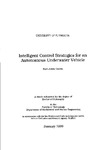Intelligent Control Strategies for an Autonomous Underwater Vehicle
| dc.contributor.author | Craven, Paul Jason | |
| dc.contributor.other | School of Engineering, Computing and Mathematics | en_US |
| dc.date.accessioned | 2013-11-06T11:28:12Z | |
| dc.date.available | 2013-11-06T11:28:12Z | |
| dc.date.issued | 1999 | |
| dc.identifier | NOT AVAILABLE | en_US |
| dc.identifier.uri | http://hdl.handle.net/10026.1/2628 | |
| dc.description.abstract |
The dynamic characteristics of autonomous underwater vehicles (AUVs) present a control problem that classical methods cannot often accommodate easily. Fundamentally, AUV dynamics are highly non-linear, and the relative similarity between the linear and angular velocities about each degree of freedom means that control schemes employed within other flight vehicles are not always applicable. In such instances, intelligent control strategies offer a more sophisticated approach to the design of the control algorithm. Neurofuzzy control is one such technique, which fuses the beneficial properties of neural networks and fuzzy logic in a hybrid control architecture. Such an approach is highly suited to development of an autopilot for an AUV. Specifically, the adaptive network-based fuzzy inference system (ANFIS) is discussed in Chapter 4 as an effective new approach for neurally tuning course-changing fuzzy autopilots. However, the limitation of this technique is that it cannot be used for developing multivariable fuzzy structures. Consequently, the co-active ANFIS (CANFIS) architecture is developed and employed as a novel multi variable AUV autopilot within Chapter 5, whereby simultaneous control of the AUV yaw and roll channels is achieved. Moreover, this structure is flexible in that it is extended in Chapter 6 to perform on-line control of the AUV leading to a novel autopilot design that can accommodate changing vehicle pay loads and environmental disturbances. Whilst the typical ANFIS and CANFIS structures prove effective for AUV control system design, the well known properties of radial basis function networks (RBFN) offer a more flexible controller architecture. Chapter 7 presents a new approach to fuzzy modelling and employs both ANFIS and CANFIS structures with non-linear consequent functions of composite Gaussian form. This merger of CANFIS and a RBFN lends itself naturally to tuning with an extended form of the hybrid learning rule, and provides a very effective approach to intelligent controller development. | en_US |
| dc.description.sponsorship | The Sea Systems and Platform Integration Sector, Defence Evaluation and Research Agency, Winfrith | en_US |
| dc.language.iso | en | en_US |
| dc.publisher | University of Plymouth | en_US |
| dc.title | Intelligent Control Strategies for an Autonomous Underwater Vehicle | en_US |
| dc.type | Thesis | |
| plymouth.version | Full version: final and full version as approved by the examiners at the time of the award of your degree | en_US |
| dc.identifier.doi | http://dx.doi.org/10.24382/3555 | |
| dc.identifier.doi | http://dx.doi.org/10.24382/3555 |
Files in this item
This item appears in the following Collection(s)
-
01 Research Theses Main Collection
Research Theses Main


